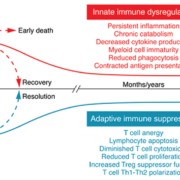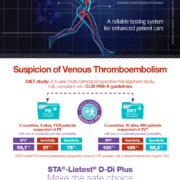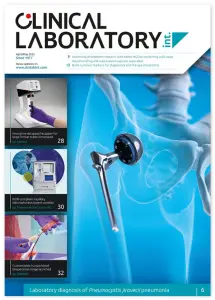Literature review: Sepsis
Extracellular vesicles as markers and mediators in sepsis
Raeven P, Zipperle J, Drechsler S. Theranostics 2018; 8(12):3348–3365
Sepsis is defined as life-threatening organ dysfunction caused by a dysregulated host response to infection. It remains a highly lethal condition in which current tools for early diagnosis and therapeutic decision-making are far from ideal. Extracellular vesicles (EVs), 30 nm to several micrometers in size, are released from cells upon activation and apoptosis and express membrane epitopes specific for their parental cells. Since their discovery two decades ago, their role as biomarkers and mediators in various diseases has been intensively studied. However, their potential importance in the sepsis syndrome has gained attention only recently. Sepsis and EVs are both complex fields in which standardization has long been overdue. In this review, several topics are discussed. First, we review current studies on EVs in septic patients with emphasis on their variable quality and clinical utility. Second, we discuss the diagnostic and therapeutic potential of EVs as well as their role as facilitators of cell communication via micro RNA and the relevance of microorganism-derived EVs. Third, we give an overview over the potential beneficial but also detrimental roles of EVs in sepsis. Finally, we focus on the role of EVs in selected intensive care scenarios such as coagulopathy, mechanical ventilation and blood transfusion. Overall, the prospect for EV use in septic patients is bright, ranging from rapid and precise (point-of-care) diagnostics, prevention of harmful iatrogenic interventions, to using EVs as guides of individualized therapy. Before the above is achieved, however, the EV research field requires reliable standardization of the current methods and development of new analytical procedures that can close the existing technological gaps.
Diagnostic accuracy of lipopolysaccharide-binding protein for sepsis in patients with suspected infection in the Emergency Department
García de Guadiana Romualdo L, Albaladejo Otón MD, Rebollo Acebes S, Esteban Torrella P, Hernando Holgado A, et al. Ann Clin Biochem 2018; 55(1): 143–148
BACKGROUND: Biomarkers can facilitate the diagnosis of sepsis, enabling early management and improving outcomes. Lipopolysaccharide-binding protein (LBP) has been reported as a biomarker for the detection of infection, but its diagnostic value is controversial. In this study, we assessed the diagnostic accuracy of LBP for sepsis in the Emergency Department (ED) patients, comparing it with more established biomarkers of sepsis, including procalcitonin (PCT) and C-reactive protein (CRP).
METHODS: LBP and other sepsis biomarkers, including PCT and CRP, were measured on admission in 102 adult patients presenting with suspected infection. Classification of patients was performed using the recently updated definition for sepsis (Sepsis-3). The diagnostic accuracy of LBP, CRP and PCT for sepsis was evaluated by using receiver operating characteristic curve (ROC) analysis.
RESULTS: A total of 49 patients were classified as having sepsis. In these patients, median (interquartile range) LBP (41.8 [41.1] µg/dL vs 26.2 [25] µg/dL), CRP (240 [205] mg/L vs 160 [148] mg/dL) and PCT (5.19 [13.68] µg/L vs 0.39 [1.09] µg/L) were significantly higher than in patients classified as not having sepsis (P<0.001 for all three biomarkers). ROC curve analysis and area under curve (AUC) revealed a value of 0.701 for LBP, similar to CRP (0.707) and lower than that for PCT (0.844) (P=0.012).
CONCLUSION: In adult ED patients with suspected infection, the diagnostic accuracy for sepsis of LBP is similar to that of CRP but lower than that of PCT.
An innovative approach for the integration of proteomics and metabolomics data in severe septic shock patients stratified for mortality
Cambiaghi A, Díaz R, Martinez JB, Odena A, Brunelli L, et al. Sci Rep 2018; 8(1):6681
In this work, we examined plasma metabolome, proteome and clinical features in patients with severe septic shock enrolled in the multicentre ALBIOS study. The objective was to identify changes in the levels of metabolites involved in septic shock progression and to integrate this information with the variation occurring in proteins and clinical data. Mass spectrometry-based targeted metabolomics and untargeted proteomics allowed us to quantify absolute metabolite concentration and relative protein abundance. We computed the ratio D7/D1 to take into account their variation from day 1 (D1) to day 7 (D7) after shock diagnosis. Patients were divided into two groups according to 28-day mortality. Three different elastic net logistic regression models were built: one on metabolites only, one on metabolites and proteins and one to integrate metabolomics and proteomics data with clinical parameters. Linear discriminant analysis and partial least squares discriminant analysis were also implemented. All the obtained models correctly classified the observations in the testing set. By looking at the variable importance (VIP) and the selected features, the integration of metabolomics with proteomics data showed the importance of circulating lipids and coagulation cascade in septic shock progression, thus capturing a further layer of biological information complementary to metabolomics information.
Validity of biomarkers in screening for neonatal sepsis – a single-center hospital-based study
Rashwan NI, Hassan MH, Mohey El-Deen ZM, Ahmed AE. Pediatr Neonatol 2018; doi: 10.1016/j.pedneo.2018.05.001 [Epub ahead of print]
BACKGROUND: The diagnosis of neonatal sepsis still considered to be a challenge for both clinicians and the laboratory owing to the non-specific clinical presentations. The present study aimed to compare and assess the diagnostic and prognostic values of C-reactive protein (CRP), high sensitivity CRP (hsCRP), presepsin, interleukin-6 (IL-6) and procalcitonin (PCT) in neonatal sepsis separately and in combination.
METHODS: This hospital-based cross-sectional study has been conducted on 168 neonates recruited from the Neonatal Intensive Care Unit of Qena University Hospitals, Upper Egypt. Measurements of CRP using the latex agglutination test, hsCRP, presepsin, IL6 and PCT assays using commercially available ELISA assay kits were done to all included neonates.
RESULTS: There were significantly higher serum levels of CRP among late onset versus early onset sepsis group with significantly higher serum levels of hsCRP and presepsin among early onset compared with the late onset sepsis group (P<0.05 for all). There were significantly higher hsCRP, presepsin and PCT serum levels in proven versus probable sepsis group (P<0.05 for all). Significantly higher serum levels of presepsin and PCT were noted among survivors versus non-survivors sepsis group (P<0.05 for all). The cut-off value of the serum level of CRP >6 mg/dL showed lower sensitivity and specificity than that of hsCRP at cut-off >140 ng/mL in diagnosing neonatal sepsis. The cut-off value of presepsin >200 ng/mL showed equal sensitivity and specificity to IL-6 at cut-off >22 pg/mL. The cut-off value of PCT at >389 pg/mL showed sensitivity and specificity approximate to that of hsCRP.
CONCLUSIONS: CRP could be a helpful prognostic marker in late onset neonatal sepsis. hsCRP and PCT have higher diagnostic accuracy in neonatal sepsis in comparison to other studied markers. Both IL-6 and presepsin have equal diagnostic utility in neonatal sepsis, but presepsin could be a helpful diagnostic marker in early onset neonatal sepsis.
Plasma miRNA-223 correlates with risk, inflammatory markers as well as prognosis in sepsis patients
Wu X, Yang J, Yu L, Long D. Medicine 2018; 97(27):e11352
The purpose was to evaluate the role of plasma microRNA-223 (miRNA-223) in risk and prognosis in sepsis patients, and its correlation with inflammatory markers. In this study, 187 sepsis patients from July 2015 to December 2016 were consecutively enrolled. Blood samples from septic patients and healthy controls (HCs) were collected, and plasma was separated for miRNA-223 expression detected by quantitative real-time PCR (qPCR). Enzyme-linked immune sorbent assay (ELISA) was performed to detect inflammatory markers. The results were as follows: miRNA-223 was highly expressed in sepsis patients compared to HCs (P<0.001). Receiver operating characteristic (ROC) curve revealed miRNA-223 disclosed a good diagnostic value of sepsis with area under curve (AUC) of 0.754, 95 % CI: 0.706–0.803. Sensitivity and specificity were 56.6 % and 86.6 % at the best cut-off point, respectively. Multivariate logistic analysis indicated that miRNA-223 could predict sepsis risk independently. Spearman’s correlation disclosed that miRNA-223 relative expression positively correlated with APCHE II score (r=0.459, P<0.001), CRP (r=0.326, P<0.001), TNFα (r=0.325, P<0.001), IL-1β (r=0.165, P=0.024), IL-6 (r=0.229, P=0.002) and IL-8 (r=0.154, P=0.035), while it negatively correlated with IL-10 (r=−0.289, P<0.001). miRNA-223 expression in non-survivors was higher than that in survivors (P<0.001). ROC curve revealed miRNA-223 could distinguish sepsis non-survivors from survivors with AUC of 0.600, 95 % CI: 0.505–0.695. Sensitivity and specificity were 83.5 % and 38.9 % respectively at the best cut-off point. In conclusion, plasma miRNA-223 correlates with disease severity and inflammatory markers levels, and it might serve as a novel diagnostic and prognostic biomarker in sepsis patients.
Biomarkers of endothelial dysfunction predict sepsis mortality in young infants: a matched case-control study
Wright JK, Hayford K, Tran V, Al Kibria GM, Baqui A, et al. BMC Pediatr 2018; 18(1):118
BACKGROUND: Reducing death due to neonatal sepsis is a global health priority, although there are limited tools to facilitate early recognition and treatment. We hypothesized that measuring circulating biomarkers of endothelial function and integrity (i.e. Angiopoietin-Tie2 axis) would identify young infants with sepsis and predict their clinical outcome.
METHODS: We conducted a matched case-control (1:3) study of 98 young infants aged 0–59 days of life presenting to a referral hospital in Bangladesh with suspected sepsis. Plasma levels of Ang-1, Ang-2, sICAM-1, and sVCAM-1 concentrations were measured at admission. The primary outcome was mortality (n=18); the secondary outcome was bacteremia (n=10).
RESULTS: Ang-2 concentrations at presentation were higher among infants who subsequently died of sepsis compared to survivors (aOR 2.50, P=0.024). Compared to surviving control infants, the Ang-2:Ang-1 ratio was higher among infants who died (aOR 2.29, P=0.016) and in infants with bacteremia (aOR 5.72, P=0.041), and there was an increased odds of death across Ang-2:Ang-1 ratio tertiles (aOR 4.82, P=0.013).
CONCLUSIONS: This study provides new evidence linking the Angiopoietin-Tie2 pathway with mortality and bacteremia in young infants with suspected sepsis. If validated in additional studies, markers of the angiopoietin-Tie2 axis may have clinical utility in risk stratification of infants with suspected sepsis.
Development and first evaluation of a novel multiplex real-time PCR on whole blood samples for rapid pathogen identification in critically ill patients with sepsis
van de Groep K, Bos MP, Savelkoul PHM, Rubenjan A, Gazenbeek C, et al. Eur J Clin Microbiol Infect Dis 2018; 37(7):1333–1344
Molecular tests may enable early adjustment of antimicrobial therapy and be complementary to blood culture (BC) which has imperfect sensitivity in critically ill patients. We evaluated a novel multiplex real-time PCR assay to diagnose bloodstream pathogens directly in whole blood samples (BSI-PCR). BSI-PCR included 11 species- and four genus-specific PCRs, a molecular Gram-stain PCR, and two antibiotic resistance markers. We collected 5 mL blood from critically ill patients simultaneously with clinically indicated BC. Microbial DNA was isolated using the Polaris method followed by automated DNA extraction. Sensitivity and specificity were calculated using BC as reference. BSI-PCR was evaluated in 347 BC-positive samples (representing up to 50 instances of each pathogen covered by the test) and 200 BC-negative samples. Bacterial species-specific PCR sensitivities ranged from 65 to 100 %. Sensitivity was 26 % for the Gram-positive PCR, 32 % for the Gram-negative PCR, and ranged 0 to 7 % for yeast PCRs. Yeast detection was improved to 40 % in a smaller set-up. There was no overall association between BSI-PCR sensitivity and time-to-positivity of BC (which was highly variable), yet Ct-values were lower for true-positive versus false-positive PCR results. False-positive results were observed in 84 (4 %) of the 2200 species-specific PCRs in 200 culture-negative samples, and ranged from 0 to 6 % for generic PCRs. Sensitivity of BSI-PCR was promising for individual bacterial pathogens, but still insufficient for yeasts and generic PCRs. Further development of BSI-PCR will focus on improving sensitivity by increasing input volumes and on subsequent implementation as a
bedside test.
From traditional biochemical signals to molecular markers for detection of sepsis after burn injuries
Muñoz B, Suárez-Sánchez R, Hernández-Hernández O, Franco-Cendejas R, Cortés H, Magaña JJ. Burns 2018; doi: 10.1016/j.burns.2018.04.016 [Epub ahead of print]
Sepsis is a life-threatening organ-dysfunction condition caused by a dysregulated response to an infectious condition that can cause complications in patients with major trauma. Burns are one of the most destructive forms of trauma; despite the improvements in medical care, infections remain an important cause of burn injury-related mortality and morbidity, and complicated sepsis predisposes patients to diverse complications such as organ failure, lengthening of hospital stays, and increased costs. Accurate diagnosis and early treatment of sepsis may have a beneficial impact on clinical outcome of burn-injured patients. In this review, we offer a comprehensive description of the current and traditional markers used as indicative of sepsis in burned patients. However, although these are markers of the inflammatory post-burn response, they usually fail to predict sepsis in severely burned patients because they do not reflect the severity of the infection. Identification and measurement of biomarkers in early stages of infection is important in order to provide a timely response and the effective treatment of burned patients. Therefore, we compiled important experimental evidence, demonstrating novel biomarkers, including molecular markers such as genomic DNA variations, alterations of transcriptome profiling (mRNA, miRNAs, lncRNAs and circRNAs), epigenetic markers, and advances in proteomics and metabolomics. Finally, this review summarizes next-generation technologies for the identification of markers for detection of sepsis after burn injuries.












